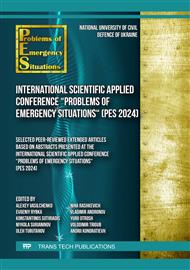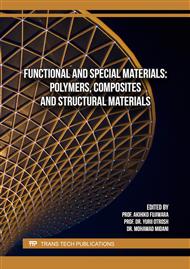[1]
S.C. Bayne, Perspectives. Our future in restorative dental materialis. J. Esthet. Dent, (2000) 175–183.
Google Scholar
[2]
T. Berry, J. Nicholson, K. Troendle, Almost two centuries with amalgam: where are we today? J. Am. Dent. Assoc. 125(4) (1994) 392–329.
DOI: 10.14219/jada.archive.1994.0053
Google Scholar
[3]
M. Toledano, E. Osorio, F. S. Aguilera, M. Toledano-Osorio, M. T. López-López, R. Osorio, Stored potential energy increases and elastic properties alterations are produced after restoring dentin with Zn-containing amalgams. Journal of the Mechanical Behavior of Biomedical Materials. 91 (2019) 109–121.
DOI: 10.1016/j.jmbbm.2018.12.002
Google Scholar
[4]
G. Vanherle, Dental care using silver amalgam. Verh. K. Acad. Geneeskd. Belg. 58(5) (1996) 587–634.
Google Scholar
[5]
W.W. Goon, A.A. Lugassy, Periapical electrolytic corrosion in the failure of silver point endodontic restorations: report of two cases. Quintessence. Int. 26(9) (1995) 629–633.
Google Scholar
[6]
J.D. Scholtanus, M. Özcan, Clinical longevity of extensive direct composite restorations in amalgam replacement: up to 3.5 years follow-up. J. Dent. 42 (2014) 1404–1410.
DOI: 10.1016/j.jdent.2014.06.008
Google Scholar
[7]
J. W. Hofsteenge, J. D. Scholtanus, M. Özcan, I. M. Nolte, M. S. Cune, M. M.M. Gresnigt, Clinical longevity of extensive direct resin composite restorations after amalgam replacement with a mean follow-up of 15 years. Journal of Dentistry. 130 (2023) 104409.
DOI: 10.1016/j.jdent.2023.104409
Google Scholar
[8]
M. Toledano, F. S. Aguilera, E. Osorio, I. Cabello, M. Toledano-Osorio, R. Osorio. Mechanical and chemical characterisation of demineralised human dentine after amalgam restorations. Journal of the Mechanical Behavior of Biomedical Materials. 47 (2015) 65–76.
DOI: 10.1016/j.jmbbm.2015.03.012
Google Scholar
[9]
P. Herrstrym, B. Hygstedt, Clinical study of oral galvanism: no evidence of toxic mercury exposure but anxiety disorder an important background factor. Scand. J. Dent. Res. 101(4) (1993) 232–237.
DOI: 10.1111/j.1600-0722.1993.tb01111.x
Google Scholar
[10]
A.J. Certosimo, R.P. O'Connor, Oral electricity. Gen. Dent. 44 (1996) 4 324–326.
Google Scholar
[11]
T.P. Skrypnikova, V.YA. Melʹnyk, Diya riznoridnykh metaliv na slyzovu obolonku porozhnyny rota. Osnovni stomatolohichni zakhvoryuvannya, yikh profilaktyka ta likuvannya. – Poltava, 1996. p.151–152 [in Ukrainian].
Google Scholar
[12]
R.H. Kuijs, W.M.M. Fennis, C.M. Kreulen, F.J.M. Roeters, N. Verdonschot, N.H.J. Creugers, A comparison of fatigue resistance of three materials for cusp-replacing adhesive restorations. J. Dent. 34 (2006) 19–25.
DOI: 10.1016/j.jdent.2005.02.010
Google Scholar
[13]
V.F. Makyeyev, A.YU. Kordiyak, L.H. Horokh, S.M. Chayka, Halʹvanichni protsesy v porozhnyni rota ta yikh vplyv na orhanizm lyudyny. Chastyna 1. Aktyvnistʹ poverkhni metalevykh zubnykh proteziv ta elektrokhimichni reaktsiyi pry vzayemodiyi metal-rotova ridyna. Novyny stomatolohiyi. 4 (21) (1999) 74–78 [in Ukrainian].
Google Scholar
[14]
V.F. Kutsevlyak, Ye.K. Sevidova, M.G. Shchegoleva, A.V. Vasilchenko, Elektrokhimicheskiye i korrozionnyye issledovaniya plombirovochnykh amal'gamnykh materialov. Vísnyk stomatologíí̈. 4 (1999) 7–9.
Google Scholar
[15]
Mariy Shyogoleva, Olena Sevidova, Alexey Vasilchenko, Irуna Stepanova, Assessment of Electrochemical Compatibility of Structural Materials of Some Dental Products. Materials Science Forumю 1006 (2020) 253–258.
DOI: 10.4028/www.scientific.net/msf.1006.253
Google Scholar
[16]
A.V. Vasilchenko, Ye.K. Sevidova, O vliyanii depassivatsii na toki gal'vanopar pri korrozionnykh protsessakh v mekhanicheskikh ustroystvakh. Problemy pozharnoy bezopasnosti. 12 (2002) 56–60.
Google Scholar
[17]
V.F. Kutsevlyak, O.K. Sevidova, M.G. Schogoleva, O.V. Vasilchenko, Declaratory patent for an invention UA No. 55906 A, 2002076060 (2003). Sposib diagnostiki galvanoziv.
Google Scholar
[18]
M.D. Sakhnenko, M.V. Vedʹ, T.P. Yaroshok. Osnovy teoriyi koroziyi ta zakhystu metaliv. NTU "KHPI", Kharkiv, 2005.
Google Scholar



